The Most Beautiful Synagogues in the World
Today we tour the most beautiful Jewish temples in the world. Since the destruction of the Jerusalem temple at the hands of the Romans and the Diaspora, the world has been filled with synagogues.
The temples where the Hebrew faith is professed. Because the Jewish people dispersed throughout the world, today we have excellent examples of their temples in many countries.
In this article, we take a look at the most lavish of all. Join us! And, if you want more information about the fascinating history and art of this town, we recommend our articles on the most beautiful Jewish neighborhoods in the world and what to do and what not to do in a synagogue.
Budapest Synagogue
Budapest was one of the European cities with the greatest presence of the Jewish community. In fact from Budapest is Theodor Hertzl, one of the founders of Zionism in the 19th century.
Although the Nazi extermination of the Hebrew people was especially vicious in the Hungarian capital, it still maintains a strong Jewish community today.
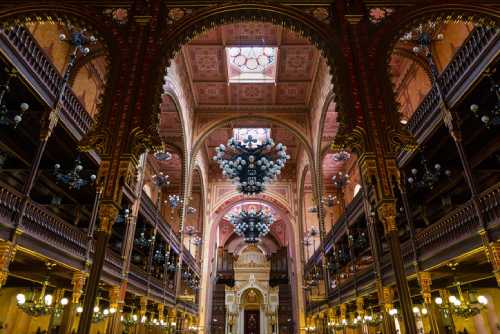
The historical relevance of this community throughout its history has meant that Budapest can boast one of the most beautiful synagogues in the world. Built in the mid-19th century in a lavish neo-Moorish style, it is today one of the most visited monuments in the pearl of the Danube.
Subotica Synagogue (Serbia)
We are now going to Serbia, although, somehow we are still in Hungary. And part of the current Orthodox country belonged to the Kingdom of Hungary. This is especially visible in the lavish Subotica Synagogue, designed by Hungarian architects Marcell Komor and Dezső Jakab in 1901.
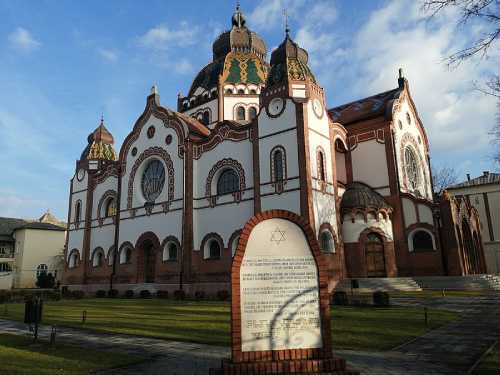
The building, considered the second largest synagogue in Europe, is built in a lavish Sezession style. Or, what is the same, Central European Modernism.
In fact, if you walk around Budapest you will find very similar buildings. Without going any further, the famous Museum of Applied Arts, of which, to a large extent, this synagogue seems to be a replica.
Jubilee Synagogue (Prague)
Prague, like Budapest, is a city that has historically been home to a notable Jewish community. In this sense, we only have to remember the ancestry of one of the most immortal Prague personalities: Franz Kafka.
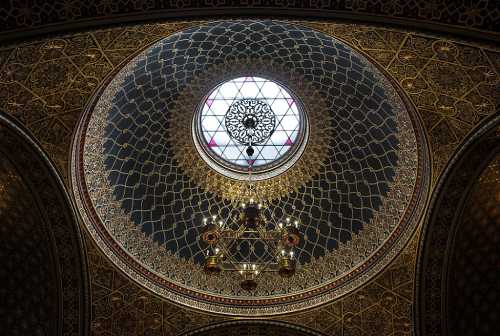
Not to mention the Hebrew legacy still visible today in its fascinating Jewish cemetery. Or being the original city of legends as associated with Hebrew as the Golem. In short, we could list everything that the city of Vltava preserves associated with Judaism and we would not finish. In fact, the city has several synagogues, such as the High Synagogue or the Old-New Synagogue.
However, we want to bring the one known as the Spanish Synagogue for its splendor. Despite its name, it has nothing to do with the Sephardic community. Rather, it alludes to its neo-Moorish style that took medieval Spanish architecture as a reference.
Elridge Street Synagogue (New York)
We are going to the New World. Place where Jews also went, forming large communities, especially those from Eastern Europe. It was this community, in fact, that was behind the construction of this synagogue. Erected in 1887, it is today one of the most famous in the city.
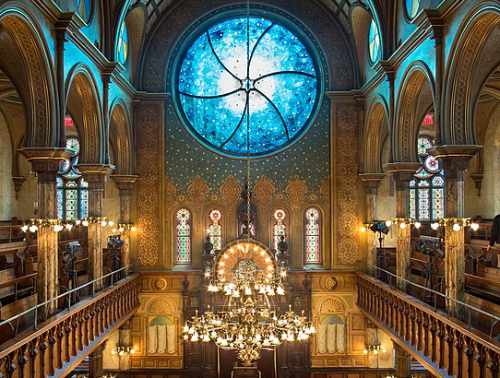
Although its design is certainly eclectic (the exterior is sometimes reminiscent of a Gothic cathedral), you have to enter to see the Hebrew elements. Especially the Star of David in one of the stained glass windows. A play of lights and unique symbolism.
Isaac Synagogue (Krakow)
So far we have taken a tour of relatively recent synagogues. Most of them were built in the second half of the 19th century in an architectural style very dependent on the eclecticism then in vogue. In this case we are going to an older synagogue, nothing more and nothing less than the 17th century.
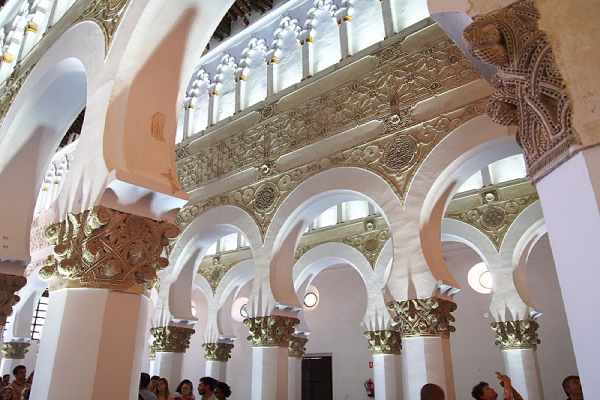
Located in the Jewish neighborhood of Kazimierz in Krakow, it is an immersion in the Hebrew heritage of Eastern Europe. In fact, it is still considered one of the best preserved Jewish neighborhoods. Which is the same as saying that it is one of the spaces historically inhabited by Jews that best avoided religious intolerance (and Nazism).
It is not an exuberant synagogue, but rather stripped down and with elements reminiscent of the baroque so in vogue during the 17th century. However, it is a chance to visit one of the few standing ancient synagogues in Europe. In addition, events and concerts closely related to Jewish culture often take place inside.
Synagogue of Santa María la Blanca (Toledo)
We could not leave Spain off the list, the birthplace of one of the strongest and most influential historical Jewish communities: the Sephardim. In fact, the Jewish legacy in Spain is visible in its multiple manifestations.
One of the most beautiful, without a doubt, is the one known as the Synagogue of Santa María la Blanca, in Toledo. The city of the Tagus is often described as the “City of Three Cultures”, given that the three main monotheistic religions coexisted there.
Read Also: The 10 Largest Religions In The World
Built in 1180 in Mudejar style, it was expropriated and converted to Catholic worship, although today no rites take place inside. Therefore, it is completely visitable. Without a doubt an ancient synagogue like few others (and extraordinarily well preserved).

![10 Best Universities to Study Naval Engineering in Canada [2024] 11 10 Best Universities to Study Naval Engineering in Canada](https://allroundgist.com/wp-content/uploads/2024/01/best-universities-to-study-naval-engineering-in-canada_1.jpg)



![Meet The 10 Richest Men In Kenya 2021/2022 [Forbes Updated] 15 Meet The 10 Richest Men In Kenya [Forbes Updated]](https://allroundgist.com/wp-content/uploads/2022/03/richest-men-in-kenya-img_1-min.jpg)
![10 Best Universities to Study Aeronautical Engineering in Canada [2024] 16 10 Best Universities to Study Aeronautical Engineering in Canada](https://allroundgist.com/wp-content/uploads/2024/01/best-universities-to-study-aeronautical-engineering-in-canada_1.jpg)
https://t.me/s/iGaming_live/4871
buy tiktok ads accounts https://tiktok-ads-account-buy.org
buy tiktok business account https://buy-tiktok-ads-account.org
verified bm https://buy-business-manager-accounts.org/
buy verified bm facebook https://verified-business-manager-for-sale.org/
unlimited bm facebook buy-bm.org
facebook bm account buy buy-business-manager-verified.org
buy verified facebook https://business-manager-for-sale.org/
unlimited bm facebook buy-verified-business-manager.org
buy verified business manager facebook https://buy-verified-business-manager-account.org
facebook bm for sale facebook bm account
buy verified facebook https://buy-business-manager-acc.org/
buy google ad threshold account buy google ads accounts
old google ads account for sale https://buy-verified-ads-account.work
buy fb bm https://buy-business-manager.org
buy google ads agency account google ads accounts for sale
google ads account seller https://buy-ads-agency-account.top/
buy google ads invoice account google ads agency account buy
google ads account seller https://buy-ads-invoice-account.top
buy verified google ads accounts https://ads-account-buy.work
buy google ads https://ads-account-for-sale.top
facebook ad account buy https://buy-accounts.click
old google ads account for sale https://buy-ads-accounts.click
buy google ads accounts https://buy-ads-account.top
cheap facebook advertising account https://ad-accounts-for-sale.work
facebook ad account for sale https://buy-ad-account.click
buy a facebook ad account cheap facebook advertising account
facebook accounts to buy fb account for sale
facebook ad account for sale https://ad-account-buy.top
buy facebook account cheap facebook accounts
facebook ad account for sale https://buy-ad-account.top
facebook accounts to buy https://buy-ad-accounts.click
facebook account sale buy-adsaccounts.work
маркетплейс аккаунтов соцсетей kupit-akkaunt.online
купить аккаунт https://akkaunty-dlya-prodazhi.pro
маркетплейс аккаунтов соцсетей https://online-akkaunty-magazin.xyz/
продажа аккаунтов https://akkaunty-optom.live/
купить аккаунт https://kupit-akkaunty-market.xyz
магазин аккаунтов https://akkaunty-market.live
маркетплейс аккаунтов https://akkaunt-magazin.online/
биржа аккаунтов https://kupit-akkaunt.xyz
продать аккаунт https://rynok-akkauntov.top
маркетплейс аккаунтов https://akkaunty-na-prodazhu.pro
account trading https://accounts-marketplace-best.pro/
account purchase https://accounts-marketplace.online
secure account sales https://buy-accounts.live/
buy pre-made account https://social-accounts-marketplace.live
buy and sell accounts https://accounts-marketplace.art
online account store https://buy-accounts-shop.pro
website for selling accounts https://buy-accounts.space
secure account purchasing platform https://social-accounts-marketplace.xyz
account sale https://accounts-marketplace.live/
marketplace for ready-made accounts buy accounts
accounts market https://buy-best-accounts.org/
purchase ready-made accounts https://accounts-marketplace.xyz
website for selling accounts https://accounts-offer.org
account selling platform accounts for sale
online account store account catalog
account trading platform social media account marketplace
account purchase find accounts for sale
sell pre-made account find accounts for sale
account exchange service account marketplace
profitable account sales guaranteed accounts
ready-made accounts for sale marketplace for ready-made accounts
account buying platform account exchange
accounts market profitable account sales
secure account sales account trading platform
ready-made accounts for sale account buying platform
account exchange service sell accounts
social media account marketplace secure account sales
account purchase account trading
account trading platform accounts market
buy accounts buy-soc-accounts.org
account market account trading platform
buy and sell accounts buy account
account trading verified accounts for sale
account exchange service account market
account trading account marketplace
buy accounts buy account
account trading service website for buying accounts
secure account purchasing platform https://buyaccountsdiscount.com/
account acquisition account acquisition
sell pre-made account accounts marketplace
account trading platform accounts marketplace
Account Exchange Service Sell accounts
Verified Accounts for Sale Account Store
Marketplace for Ready-Made Accounts Sell accounts
Online Account Store https://socialmediaaccountsshop.com
Purchase Ready-Made Accounts Marketplace for Ready-Made Accounts
Purchase Ready-Made Accounts Accounts for Sale
Guaranteed Accounts Account Trading
Sell accounts Buy and Sell Accounts
Secure Account Sales Profitable Account Sales
Gaming account marketplace https://accountsmarketplacepro.com
Account Selling Service Account exchange
маркетплейс аккаунтов услуги по продаже аккаунтов
магазин аккаунтов магазин аккаунтов социальных сетей
маркетплейс аккаунтов покупка аккаунтов
перепродажа аккаунтов аккаунты с балансом
покупка аккаунтов перепродажа аккаунтов
маркетплейс аккаунтов соцсетей marketplace-akkauntov-top.ru/
маркетплейс аккаунтов услуги по продаже аккаунтов
маркетплейс аккаунтов соцсетей купить аккаунт
площадка для продажи аккаунтов продать аккаунт
покупка аккаунтов маркетплейс аккаунтов
продажа аккаунтов заработок на аккаунтах
покупка аккаунтов площадка для продажи аккаунтов
услуги по продаже аккаунтов услуги по продаже аккаунтов